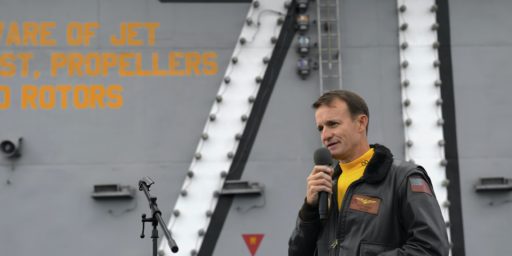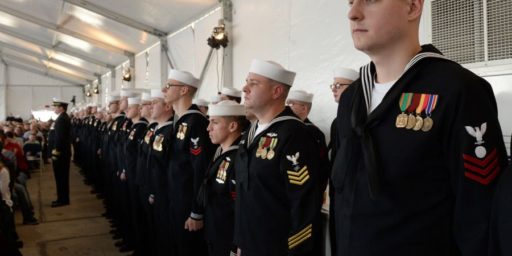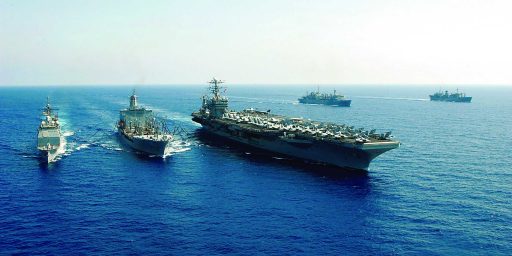Privatizing the Navy
Washington Times/AP: Navy brings civilians on board to cut costs
Chief engineer Andrew Busk wears jeans and a T-shirt to work, and he doesn̢۪t salute when the captain walks by. Although Busk is in charge of the engine room of the U.S. 7th Fleet̢۪s temporary flagship, he isn̢۪t even in the Navy.
He could, however, be the look of its future.
Reflecting increasing pressure to cut costs and shift personnel to where they are most needed, the USS Coronado recently sailed into Yokosuka, the fleet̢۪s home port just south of Tokyo, with a mostly civilian crew in an experiment officials say could have broad implications for the way the Navy staffs its ships.
Stretched thin by fiscal restraints and the demands of supporting operations in Iraq and elsewhere, the Navy is streamlining its forces. As part of the changes, it is cutting nearly 8,000 personnel — for an estimated annual savings of nearly $1 billion.
Although the top command, weapons and other key positions are reserved for military personnel, civilians outnumber military sailors on the San Diego-based Coronado 153 to 117. The size of the crew is also significantly smaller — about 200 fewer than usual.
Officers say the crew reduction is possible mainly because of the experience the civilians bring with them. Although most Navy ships carry many young sailors still learning how to do their jobs, the civilians aboard the Coronado are seasoned mariners.
“If they want to save money, we can do the job cheaper and more effectively,†Busk said, adding he was able to cut the Coronado’s engine room staff from 18 to three by increasing automation and cutting redundancy.
Unlike their enlisted counterparts, civilians can be let go when they are no longer needed. They are paid about twice as much as people in uniform, but they don’t get many of the military’s benefits, including its retirement package. They also can be used for custodial or cooking tasks, freeing sailors for what Navy planners call “tip of the spear†posts.
While my capitalistic instincts tell me this makes perfect sense, my military sensibilities are more than a little skeptical. I’m sure these folks are at least as competent as the sailors they replace. Still, I can’t help but wonder how receptive civilian contractors will be to going off to war. Of course, we done it with the Merchant Marine for decades and, so far as I know (which, frankly, isn’t that far) we haven’t had any problems. This may well work but it’s an incredibly risky experiment.






James, this article might be using incorrect terminology – don’t know. Navy civilians aren’t contractors. I suppose this could be a matter of interpretation, but it is a very clear distinction in the Navy. And a very important one, I have to say.
:o)
I’m not familiar with Navy procedures but I’m pretty sure these aren’t GS-types, since they can be fired if they’re no longer needed.
Maura’s correct, these folks are Military Sealift Command employees, just like their counterparts on the MSC ships. In fact, the Coronado was briefly transfered to the MSC before they figured out that it would cause them some problems. I addressed this issue on my blog earlier today.
They can be let go from ship duty, but typically, and most often, they are GS employees, and simply go back to what they were doing, or find a cushier job in a program office.
I know because I’m going out on a ship soon. There are a few contractors, far more civvies, and I honestly don’t know jack about the Coronado, but it’s just a strong suspicion of mine. I can check into it for ya, though.
Update on the command-and-control ships – from the corpsman in the lab:
As I suspected, services (such as cooking food, etc) are provided by contractors. Mission control, analysis, engineering, and research (ie human factors, flight performance testing) is by civvies, (and officers) more often than by contractors. Much more.
So, depending on the mission, the ship, and current politics, it could be more civvies or more contractors.
Didn’t the romans already try this experiment? I don’t think they were happy with the results.